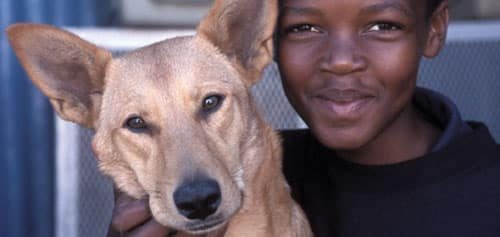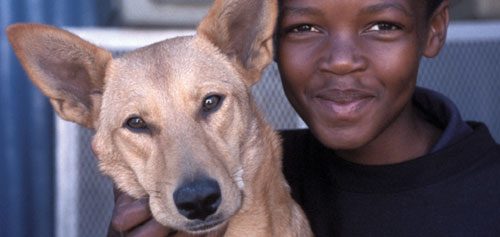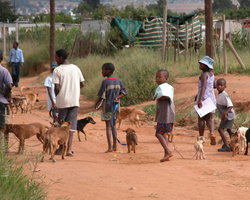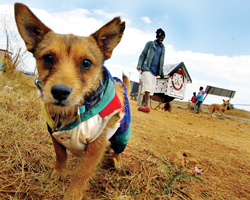

Health And Hope
Dogs of a South African township
Cape Town is a beautiful city. Ringed by a flat-topped rise called Table Mountain, Arcadian wine country, and a wide open sea that stretches to Antarctica, it’s a favourite of European vacationers and draws comparisons to San Francisco. The drive from the airport into town, however, isn’t pretty. The N2 highway runs along a length of one of the ugliest stretches of the city: the township or informal settlement called Khayelitsha.
A fence separates Khayelitsha from the road and behind the fence is another world. Shanties made of corrugated tin, scraps of wood, and rubbish are hewn together into lopsided houses. Tin roofs are held down by rocks, tires, shopping carts—anything heavy. Electricity poles stand like sentries with wires sloping down to nearby shacks like ribbons on a maypole.

It’s also home to a countless number of dogs.
In the middle of Khayelitsha, located in three converted shipping containers, sits the Mdzananda animal clinic, a project of the International Fund for Animal Welfare (IFAW). The staff of the Mdzananda clinic—the only veterinary facility in the township—are all Khayelitsha residents. Until recently, when IFAW was able to purchase land, the clinic, like many of the residents of Khayelitsha, squatted illegally on a parcel of land, and stole electricity and water to survive. Residents bring their dogs to Mdzananda for basic vet care: deworming, flea/tick dips, spaying, and neutering—all of which are encouraged through outreach programs. The clinic also treats endless cases of tick bite fever, ringworm, hookworm, mange, and malnutrition. A growing problem is poison. Residents buy an illegal industrial farming poison to kill rats. It doesn’t work; the rats stay away, but the dogs find it and eat it.
“We are finding more dogs dying from rat poison. The other day someone brought in three dying dogs in a wheelbarrow,” says Jane Levinson, project coordinator for Mdzananda.
Inside the clinic is a smell that is equal parts wet dog, ammonia, and a sweet medicinal odour from sterilization. The noise is a buzz of dogs being shaved for surgery and the scurry of dogs waking uncertainly and ripping at the newspaper-covered floor of their cages. The barking sounds confused, uncertain.
A number of dogs live at the clinic. There is AJ, a dog with a mangled paw. AJ was hit by a car. His paw is raw, twisted upside down with the permanent look of a wound that isn’t quite healed, but he hops around and frolics with the other dogs.

One dog was dropped off by a man who said his neighbour abandoned the animal when he was sent to jail. The dog had exposed black skin where his fur had worn away from sitting and laying on concrete. He was severely emaciated, his ribs protruding and all his bones visible, including the outline of his hips. His skin hung slack, showing dehydration, and he was infested with hundreds of ticks. This beautiful dog, maybe part Mastiff and part Golden Retriever, laid there, semi-conscious, his eyes unresponsive and his gums completely grey.
Clinic worker Cora Bailey sat next to the dog and stroked his head, thinking: this dog is not going to make it. But Bailey produced a pack of food and pushed it carefully into the dog’s mouth. At first the dog, with his last reserves of strength, swallowed as if by rote, seeming to hardly realize he was eating. But as recognition took hold, he propped himself up and began licking the package of food, first slowly, then faster, greedily.

“Let’s call this dog Lazzie,” suggested Bailey. “He’s just like Lazarus, returned from the dead.”
Every day, half of the staff ventures out from the clinic in search of dogs that need medical attention, operating daily mobile clinics at fixed locations in the townships.
Amidst the poverty and disease, Levinson also finds something surprising: hope. Many of the people served by Mdzananda have little beyond the clothes on their back, but often their dogs are remarkably well cared for.
“There’s no food in the cupboard, but the dog bowl is full,” Levinson says. It’s a testament to the special bond between dogs and their guardians.
Children in matching uniforms stop by the clinic on the way home from school and Lazzie makes friends with two boys. Bailey smiles.
“We find that working with children and teaching them to be kind to animals teaches them to be kind to each other,” she says. “These kids are exposed to an enormous level of violence. We need more kindness in this country and it’s got to start somewhere.”
Join the newsletter and never miss out on dog content again!
"*" indicates required fields
By clicking the arrow, you agree to our web Terms of Use and Privacy & Cookie Policy. Easy unsubscribe links are provided in every email.